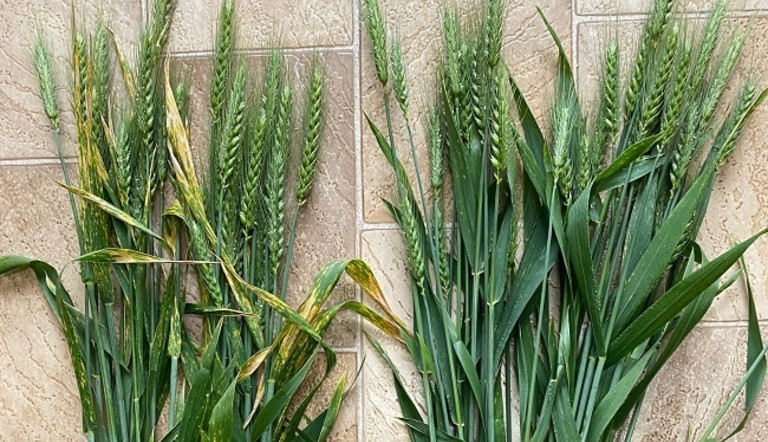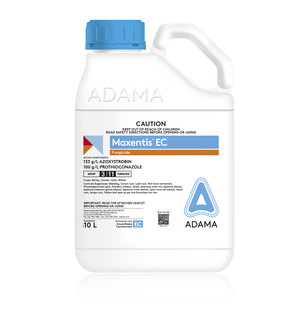
Growers brace for disease with extra fungicide options

HIGH crop disease pressure in various agriculture regions last year has many growers on high alert this cropping season.
Fortunately though, when it comes to cereal and canola crops, they can now rely on some extra fungicide options in their arsenal against disease and, importantly, these come with added flexibility and improved crop safety.
Maxentis® EC and Proviso® fungicides from ADAMA Australia, which can be used in canola, wheat, barley and oat crops, now offer more options for controlling disease and managing disease resistance, flexible application timing and better crop safety when mixed with other protection and input products.
Maxentis is a unique co-formulation of prothioconazole and azoxystrobin for control of seedling and upper canopy blackleg and sclerotinia in canola, as well as rusts, powdery mildew, septoria, yellow leaf spot, net blotches, scald and ramularia in cereals.
Proviso is a novel prothioconazole fungicide that can be used in tank mixes with a range of other crop protection and nutrition products to improve control of a broader range of diseases in canola and cereals, including fusarium head blight in wheat, and to assist disease management.
In Victoria last year, a green bridge supporting crop disease over summer, the emergence of another two, virulent stripe rust pathotypes and the prevailing wet conditions presented big challenges for numerous growers. However, a move to multiple crop disease sprays including these recently released fungicides helped to keep crops clean.
Alistair Ferrier, who farms at his family’s property between Sea Lake and Birchip and also is a member of the local Nutrien Ag Solutions team as an Agronomist, said the green bridge caught some growers off-guard with disease and then compounded by the stripe rust epidemic, it resulted in up to three fungicide applications.
“It was a unique season with disease and third sprays are unheard of in this area,’’ said Alistair, who grows wheat, barley, canola and lentils as part of a continuous cropping program on their property.
“The third sprays topped-up earlier flag leaf sprays, keeping spore loads to a minimum so when crops flowered, the heads were protected.’’
He said one fungicide spray was typically required most seasons around growth stage 37 or 39, however last year in a paddock of Scepter wheat on their property after two applications of epoxiconazole at growth stages 32 and 39, Alistair decided to apply Maxentis at ear emergence.
“We applied epoxiconazole twice, once in a mix and once by itself, and we also had incidences of powdery mildew and septoria, so we went to the azoxystrobin and prothioconazole in Maxentis.”
“We left an untreated strip and we were happy with the control provided by Maxentis – absolutely.
“At 300mL (per hectare), we were very impressed with the control of the stripe rust and it was more active on powdery mildew with the prothioconazole.’’
He said Maxentis was now another option that could be used in times of high disease pressure.
“In the tough conditions with the new virulent rust strains, and where epoxiconazole was used earlier against rust, it provided very good activity at the 300mL (/ha) rate.”
Maxentis also was used in barley and canola crops on the property last year and Alistair said it definitely provided additional crop greening benefits.
At Maroona in Victoria’s South West region, the Conboy family has typically encountered rust and septoria in their wheat crops and this was enhanced with the wet conditions and additional rust strains last season.
Archie Conboy said they had also noticed a decline in effectiveness of some existing fungicides in recent years and, in consultation with their local Gorst Rural agronomist, this led to the decision to apply Maxentis in their Bennett wheat last year.
“In this South West district, we are always looking to rotate chemistry so diseases don’t develop immunity and Maxentis allowed us to introduce another chemical into the mix and extend our disease protection,’’ Archie said.
“Due to the wet conditions, we had to apply it by plane and it was really effective and showed no effects on the crop.
“After the application, we didn’t see much rust or septoria, so we were really happy. In comparison to other fungicides we have used in previous years, Maxentis provided really good length of control of the diseases, which is something we are looking for here.
“We are definitely looking forward to including it in our cropping program – it just adds another string to the bow,’’ he said.


